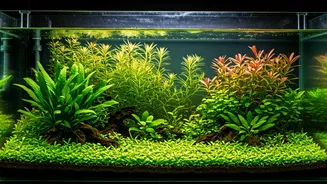Anacharis
Anacharis, often referred to as Elodea, is a superb choice for beginners because of its hardiness and fast growth. It's a fantastic oxygenator, meaning
it releases oxygen into the water, helping to keep your fish healthy. This plant is easy to propagate – you can simply trim a stem and replant it. Anacharis absorbs nutrients from the water, which helps to keep algae at bay, and it provides a hiding place for fish. To plant anacharis, you can either anchor it in the substrate or let it float freely. The ideal lighting conditions for anacharis involve moderate to bright light, but it can adapt well to various lighting conditions, making it a versatile option for different aquarium setups. Regular trimming is key to prevent it from overcrowding the tank.
Java Fern
Java Fern is another excellent plant for aquarium novices. Its slow growth and ease of care make it a good choice. Unlike many other plants, Java Fern doesn't need to be planted in the substrate; instead, it can be attached to driftwood or rocks. This is done using a fishing line or super glue that is safe for aquariums. It thrives in low-light conditions, which is helpful if you have a tank with dimmer lighting. It provides a visual appeal with its textured leaves. Java Fern prefers slightly acidic water conditions, although it is adaptable. Provide it with regular water changes to maintain its health and a healthy environment for your fish. To keep it healthy, it is essential to avoid burying the rhizome (the horizontal stem) in the substrate, as this can cause it to rot.
Amazon Sword
Amazon Sword is a larger plant, making it better suited for medium to large aquariums. This plant can grow quite tall and wide, providing a lovely focal point for your aquarium. It provides shelter for fish and contributes to the visual appeal with its broad, lush leaves. Amazon Swords thrive when planted in the substrate, where they can draw nutrients. They will benefit from nutrient-rich substrate or regular fertilization. They also appreciate moderate to bright lighting. It’s important to give them sufficient space as they grow. Regular pruning can help maintain their shape. They are relatively easy to care for, but they need the right environment to thrive. Ensure that the water conditions and lighting meet their requirements.
Cryptocoryne
Cryptocoryne, also known as 'Crypts,' is a diverse group of plants with various species, each offering different leaf shapes and colours. They're moderately easy to care for and are usually planted in the substrate. Crypts adapt well to different lighting conditions. They provide excellent hiding places for fish and add texture and visual appeal to your aquarium layout. Many Crypt species are known for their ability to tolerate lower light conditions, making them ideal for tanks with less intense lighting. Crypts can sometimes undergo a 'melt' process when introduced to a new environment, where their leaves may initially deteriorate before recovering. This is normal. It is important to monitor the plant's health and provide stable water parameters and proper lighting for optimal growth.
Dwarf Hairgrass
Dwarf Hairgrass is an excellent option if you want to create a carpet effect on the substrate. This plant spreads via runners, forming a dense, grassy appearance that creates a natural-looking environment. They require strong lighting and a nutrient-rich substrate to thrive. Dwarf Hairgrass helps to oxygenate the water and provides a hiding place for small fish and invertebrates. Regularly trimming the grass will help maintain its shape and prevent it from overgrowing. Adding CO2 can speed up its growth. Proper care includes consistent maintenance, ensuring a clean and healthy environment for both the plants and your aquatic life.
Water Wisteria
Water Wisteria is a fast-growing plant that is visually striking due to its unique leaf shape. It is easy to care for and can be planted in the substrate or allowed to float freely. It helps in the filtration of the aquarium by absorbing nitrates and other waste products. Water Wisteria thrives under moderate to high lighting conditions. It grows rapidly, providing plenty of oxygen. Regular trimming is essential to prevent it from taking over the tank and to maintain its attractive shape. Providing a balanced environment with sufficient light and nutrients will keep it healthy and contribute to the overall well-being of the aquarium.
Java Moss
Java Moss is a versatile plant that can attach to various surfaces, like driftwood, rocks, and even decorations. It is easy to care for and adaptable to different water parameters. Java Moss is a great choice for beginner aquarists. It offers shelter for small fish, helps to filter the water, and creates a natural look. It is often used to create spawning areas for fish. This plant requires moderate lighting and can thrive with low light as well. Pruning is necessary to keep it tidy and prevent it from overgrowing. Regular water changes and a clean environment will help it stay healthy.















